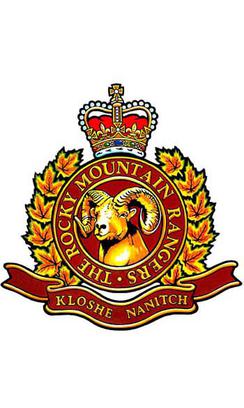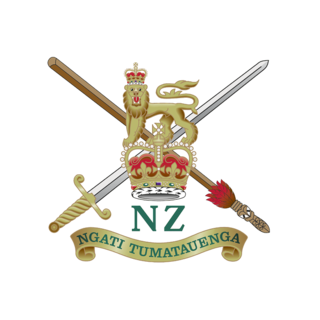Related Research Articles

A brigade is a major tactical military formation that typically comprises three to six battalions plus supporting elements. It is roughly equivalent to an enlarged or reinforced regiment. Two or more brigades may constitute a division.

The Canadian Armed Forces are the unified military forces of Canada, including land, sea, and air commands referred to as the Canadian Army, Royal Canadian Navy, and the Royal Canadian Air Force. The CAF also operates several other commands, including the Canadian Forces Intelligence Command, the Canadian Joint Operations Command, and the Canadian Special Operations Forces Command.

The 1st Canadian Division is a joint operational command and control formation based at CFB Kingston, and falls under Canadian Joint Operations Command. It is a high-readiness unit, able to move on very short notice, and is staffed and equipped to meet Canada’s military objectives to counter any potential threat.
This is a list of British ground forces in the Falklands War. For a list of ground forces from Argentina, see Argentine ground forces in the Falklands War

A Canadian Forces base or CFB is a military installation of the Canadian Armed Forces. For a facility to qualify as a Canadian Forces base, it must station one or more major units.

The Canadian Forces Military Police provide police, security and operational support services to the Canadian Armed Forces (CAF) and the Department of National Defence (DND) worldwide.

The British Columbia Dragoons (BCD) is a Primary Reserve armoured reconnaissance regiment of the Canadian Army. It is based in Kelowna and Vernon, British Columbia, and is part of 3rd Canadian Division's 39 Canadian Brigade Group.

Canadian Forces Base Baden–Soellingen or CFB Baden–Soellingen, formerly known as RCAF Station Baden–Soellingen (Baden), was a Canadian Forces base located near the farming community of Söllingen, part of the municipality of Rheinmünster in the West German state of Baden-Württemberg. It is now a commercial area called Baden Airpark, which also includes the regional airport Flughafen Karlsruhe/Baden-Baden.

The Rocky Mountain Rangers is a Primary Reserve infantry regiment of the Canadian Army, one of only four infantry regiments in British Columbia, and the only infantry unit that recruits in Northern BC and much of the Interior. The regimental headquarters are at JR Vicars Armoury in Kamloops, with an additional rifle company in Prince George. The Rocky Mountain Rangers are part of the 3rd Canadian Division's 39 Canadian Brigade Group, the brigade responsible for Canadian Army organization in British Columbia.

3rd Canadian Division Support Base Edmonton, formerly known as and commonly referred to as CFB Edmonton is a Canadian Forces base located in Sturgeon County adjacent to the City of Edmonton in Alberta, Canada. It is also known as Edmonton Garrison or "Steele Barracks".
41 Combat Engineer Regiment is an Army Reserve (militia) unit of the Canadian Military Engineers/Royal Canadian Engineers (RCE) in Alberta, Canada. The unit consists of:
A service battalion is a unit of the Canadian Armed Forces (CAF) that provides combat service support to a brigade group and its elements.

Operation Friction was a Canadian military operation that saw the contribution of 4,500 Canadian Forces personnel to the 1991 Gulf War. The larger US components were Operation Desert Shield and Operation Desert Storm.

The Primary Reserve of the Canadian Armed Forces is the first and largest of the four sub-components of the Canadian Armed Forces reserves, followed by the Supplementary Reserve, the Cadet Organizations Administration and Training Service and the Canadian Rangers.

39 Canadian Brigade Group is a Canadian Forces formation of the Canadian Army under the 3rd Canadian Division. The brigade group is composed of Canadian Forces (CF) Primary Reserve units, all of which are based within the province of British Columbia. 39 CBG Headquarters is located at the Major-General B.M. Hoffmeister OC, CB, CBE, DSO Building, 1755 West 1st Avenue, Vancouver.
Canadian Forces Europe was the Canadian Forces military formation in Europe during the Cold War. The CF assisted other NATO allies in watching the military activities of Warsaw Pact and the Soviet Union.
Area Support Unit Chilliwack is a Canadian Forces facility located in Chilliwack, British Columbia.

This article describes the current structure of the New Zealand Army. It includes the army's order of battle and the headquarters locations of major units.
The following is a hierarchical outline for the Canadian Armed Forces at the end of the Cold War. It is intended to convey the connections and relationships between units and formations.

39 Signal Regiment, formerly known as 744 Signal Regiment in Vancouver, 741 Signal Squadron in Esquimalt and 748 Signal Squadron in Nanaimo, is a Primary Reserve Canadian Army unit of the Royal Canadian Corps of Signals in Vancouver, Victoria and Nanaimo, British Columbia.